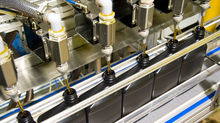Lubricant Reaction to Temperature Variation
Temperature variation results in both temporary and permanent effects on lubricants. Viscosity change as a result of temperature variation, along with water accumulation, are both temporary reactions driven by a compressor’s operating temperature. When operating temperatures are left unmanaged these temporary effects to lubricant temperature, along with the rate of oxidation, can lead to a more permanent effect. These effects are defined in greater detail below.
Viscosity changes: When compressors are started at temperatures well below freezing, several problems related to viscosity can occur. At sub-zero temperatures, an ISO 46 fluid may increase in viscosity to as much as 1000-2000 cSt depending on the Viscosity Index (VI). The higher the VI of the lubricant, the less severe the increase will be in cold weather. This is especially critical when cold starting compressors with remote oil coolers, where circulation of cold oil through long lines will cause the compressor to actually overheat and shut down on high temperature. In all cases, starting torque and amp draw will increase dramatically, and could cause a trip or even a catastrophic failure. Properly formulated compressor lubricants have good low temperature fluidity to minimize these problems, driven by the base oil selection and their VI.
The opposite problem occurs in very high temperature environments. The viscosity can be reduced so low that adequate lubrication at the bearings can no longer be achieved. For adequate protection at these higher temperatures, a fluid with a high VI and strong oxidative package will help to ensure expected fluid life.
Water accumulation:
It’s very possible to run a rotary screws compressor discharge temperature too low resulting in a low lubricant temperature. A good rule of thumb is that the discharge temperature should be 100℉ above ambient air temperature. Running too far below this discharge temperature, or in extremely humid environments can cause water to accumulate in the lubricant, and in the compressor sump. This is never good, but some fluids tolerate small amounts of water better than others. Polyglycols will tolerate up to 7000 ppm of water before the water drops out of solution as free water. For most synthetic hydrocarbons, that number is closer to 100 ppm. As long as water is low enough to stay in solution, the concern is minimal. As water levels rise on fluid analysis reports, one consideration should be to increase the discharge temperature slightly. Service staff should also look to ensure the compressor is seeing adequate run cycles to maintain operating tempertures to assist in water removal. Water cooled compressors can struggle even greater with water accumulation as they are usually capable of running too cool. Most air cooled compressors are limited in their cooling capacity by the size of the air cooler. For them, the discharge temperature will usually rise and prevent water problems, unless the compressor runs at low or no load.
Oxidation of Lubricant:
Saving the worst for last! The biggest enemy of the lubricant, which actually limits fluid life and results in premature servicing is high discharge temperature. For every 18℉ rise above the rated temperature of a lubricant (usually 190℉ or 200℉), the fluid life is cut in half. For example, a fluid that is rated for 8,000 hours at 200℉ will likely only last for approximately 4,000 hours at 218℉. At 210℉, it would be rated for about 6,000 hours. Many operators believe that as a lubricant oxidizes all lubricants react the same. PAO’s, synthetic hydrocarbons, and natural hydrocarbon fluids will usually show oxidation on an analysis as Total Acid Number (TAN). The TAN itself is not the only an indicator as viscosity may also increase. The biggest problem is that the fluids will then begin to form varnish and sludge deposits. Ultimately, this can result in plugged oil coolers, obstructed bearing orifices, and shorter separator life. With Polyglycol (PAG) lubricants, the TAN will increase with time, but no varnish forms. This avoids the problems with cooler plugging, and air end life. The lubricant should be changed after a TAN increase of 1.0 with all fluid types.
SA Performance offers the following premium lubricants to protect your rotary screw air compressor from the effects of temperature variation:
SAP 8000 – True PAG
SAP 8000 series is specially formulated as a direct equivalent for major OEM rotary screw PAG coolants. The formula is derived from the same philosophy used for those OEM PAG coolants with approximately 73% polyalkylene glycol and 17% pentaerythritol ester. This fluid is designed for 8,000 hours and has excellent heat transfer, a high flash point and resists both varnish as well as oxidation.
SAP 3000 – SH Synthetic
SAP 3000 series is a synthetic fluid for rotary screw compressors, designed for 8,000 hours of operation. This proven fluid has outstanding thermal stability, resistance to oxidation, a low pour point, and high flash point, while protecting the compressor against corrosion, rust, and wear. SAP 3000 series is a direct replacement for many PAO style lubricants commonly used by OEM’s. In cases where the temperature creeps to well above 210℉ for extended periods of time, SAP 6000 can be used to replace SAP 3000, offering enhanced thermal and oxidative stability.
Contact Us Today to Learn More About Our Premium Air Compressor Lubricants, Air End Re-manufacturing Services, and 5-year Warranty Program.























